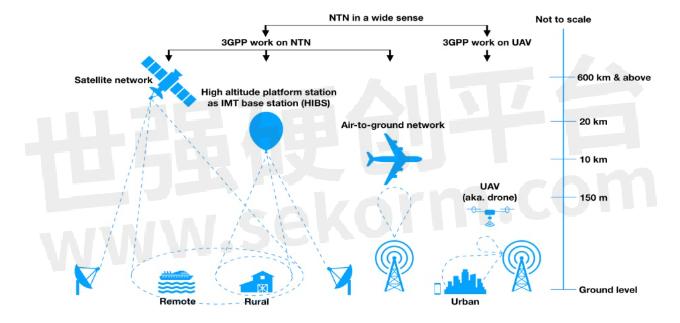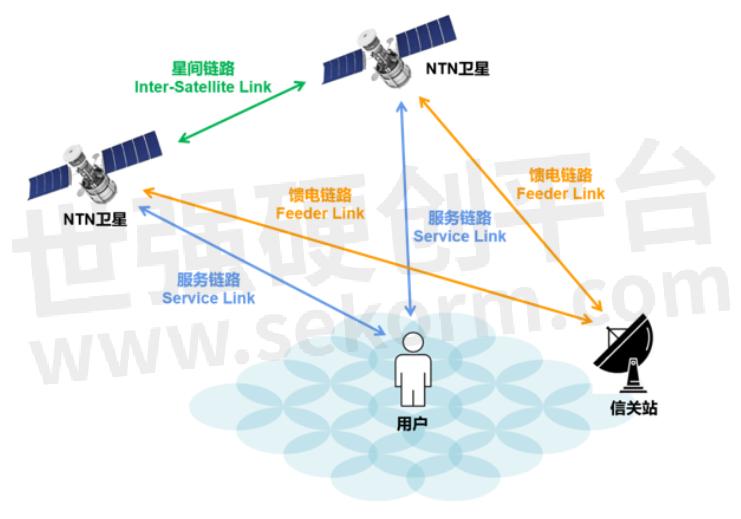5G NTN – The Revolution of Mobile Communication

What is NTN?
NTN: Non-Terrestrial Networks
NTN has become a general term for any network involving non-ground flying objects.
NTNs include Satellite Communication Networks, High Altitude Platform Systems (HAPS), and Air-to-ground networks, as shown in the figure below.

1.1 Satellite Communication Networks
Satellite Communication Networks are airborne platforms that include: LEO(Low Earth Orbiting)、MEO(Medium Earth Orbiting), and GEO(Geosynchronous Earth Orbiting). Over the past few years, there has been renewed interest in broadband services provided by LEO NTNs, which use large satellite constellations, such as Starlink、Kuiper, OneWeb, etc.
1.2 HAPS
High Altitude Platform Systems(HAPS) is an aerial platform that includes aircraft, balloons, and airships. In 3GPP’s NTN work, the focus is on high-altitude platform stations, known as International Mobile Communications Base Stations (HIBS). The HIBS system provides mobile services using the same frequency band as terrestrial mobile networks.
1.3 Air-to-ground networks
Air-to-ground networks are designed to use ground stations to provide in-flight connectivity to aircraft, and ground stations play a similar role to base stations in ground mobile networks, but the ground station antennas are tilted upwards and the distance between stations is much greater than that of ground mobile networks.
So far, 3GPP’s NTN efforts have focused on satellite communication networks, which are also compatible with HIBS systems and Air-to-ground Networks. Notably, 3GPP has also been working on mobile low-altitude unmanned aerial vehicles (UAVs, or drones), which can be considered part of the NTN family in a broad sense.
Why do we need NTN?
To understand the rise of NTN, firstly, we can think about this question:
Are mobile communication networks everywhere?
With regard to the Earth, only 29% of its land area and 71% are oceans.
Of this 29% of the land area, mobile communication network only covers 20%; In contrast, the network coverage of the ocean is even lower, only 5%.
In other words, mobile communication networks only cover about 10% of the earth’s area.
So, how to meet the communication needs of the areas without signal coverage?
How to provide efficient rescue in the face of natural disasters like floods, earthquakes, and tsunamis?
How to build a communication network with global coverage and no terrestrial restrictions? To answer the questions above, Satellite communications came into being.
5G NTN
Satellite phones
In recent years, major mobile phone manufacturers have entered the research and development of satellite mobile phones. The launch of Huawei’s M50 flagship, Apple’s iPhone 14 with GlobalStar cooperation, kicked off the consumer field of satellite communications. Due to technical limitations, these two phones don’t support satellite phones yet.
Last year, SpaceX announced reaching a spectrum-sharing agreement with T-Mobile, and the new generation of Starlink V2 satellites will provide services to mobile phones on the existing network through 1.9GHz. It means that Starlink has taken a step forward with satellite phones.
The Starlink V2 satellite has enhanced signal reception, lengthening the satellite antenna to 7 meters, increasing the panel to 25 square meters, and achieving 10 times the communication performance of the previous generation V1.
In this way, the mobile phones in the existing network can be directly connected to the satellite’s 5G signal, and the expected throughput rate can reach 2~4Mbps.
Compared with the 5G network on the ground, this 5G network floating in the sky is naturally called a “Non-Terrestrial Network.”
NTN in a broad sense covers a wide range, including unmanned aerial vehicles(UAV), surface-to-air communications, high-altitude base stations, satellite networks, and so on. Satellite-based NTNs are naturally the most focused attention, so in general, the NTNs we talk about are satellite-based.
The idea of 5G NTN is: the satellite transmits 5G signals, directly connects with the user’s mobile phone, and then sets up a signal station on the ground as a gateway, and finally connects to the 5G core network.

Among them, the link between the satellite and the user is called the Service Link; The link between the satellite and the signal station is called the Feeder Link; The link between satellites is called the Inter-Satellite Link (ISL).
With the acceleration of global satellite manufacturing and networking launch, the standard evolution of satellite Internet and the landing of scenarios are also accelerating.
In June 2022, the 3GPP R17 standard was announced, and the non-terrestrial network NTN (Non-Terrestrial Networks) is one of the important features of the R17 definition. Through the integration of ground networks and satellite networks, it provides more comprehensive coverage for individual consumers and vertical industry users. Meanwhile, it also provides support for the ubiquitous network requirements of the IoT in the 6G era
In subsequent articles, we will introduce the 3GPP standard development of NTN, the architecture of NTN-related protocols, as well as the challenges and development trends.
- +1 Like
- Add to Favorites
Recommend
This document is provided by Sekorm Platform for VIP exclusive service. The copyright is owned by Sekorm. Without authorization, any medias, websites or individual are not allowed to reprint. When authorizing the reprint, the link of www.sekorm.com must be indicated.

































































































































































































































































































































































































































































































































































































































































































































































































































































































































